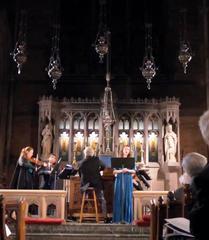|
Back
Comfort and Joy New York
Saint Ignatius in Antioch Church
12/03/2019 -
Arcangelo Corelli: Concerto Grosso (“Christmas Concerto”), Opus 6, No. 8
Michel Richard de Lalande: Noels arranged from “Simphonie des Noëls”
Georg Philipp Telemann: Cantata “In gering- und rauhen Schalen” (“Epiphany Cantata”), TWV 1:941
Alessandro Scarlatti: Cantata pastorale per la natività di Nostro Signore Gesù Cristo
Nola Richardson (Soprano), Thomas Crawford (Organ, Artistic Director, Founder)
American Classical Orchestra: Augusta McKay Lodge, Peter Kupfer (Baroque violins), Kyle Miller (Baroque viola), David Bakamjian (Baroque cello), Nina Stern (Recorder), Sarah Davol (Baroque oboe)

Ensemble/St.Ignatius of Antioch Church
(© Matthew Kaplan/American Classical Orchestra)
“Alessandro Scarlatti’s cantatas make use of all sorts of dissonance to express the force of the words. And afterwards resolves themselves so well that the most beautiful concords are hardly as sweet and harmonious as his discords.”
François Raguenet: Comparisons of French and Italian music (1709)
“I never met with any man that suffered his passions to hurry him away so much while he was playing on the violin as the famous Arcangelo Corelli, whose eyes will sometimes turn as red as fire.”
Ibid
Last night’s American Classical Orchestra performance was neither “classical” or “orchestral”. And while the few musicians who offered their Baroque music were presumably “American”, the music itself spanned 18th Century Europe: Versailles, Italy, and–from the century’s most perambulating composer–the whole of the Continent.
Whatever the definitions, Thomas Crawford, the organist, conductor and sometimes raconteur of Noël gave music which, for this listener, was the ideal example of the holiday season. Not because the gorgeous church was named after the city which gave the first rules to the Church, or because of the festive season. But because the music was written by masters who were presumably believers, and whose inspiration pervaded their very notes.
Admittedly, I chose this concert because I needed a respite from the all-pervading noise in our country today. Noise of politics, corruption, meaningless words spoken by meaningless people. Yes, a short hike in the Western Massachusetts woodland was a short respite. But returning to New York, the chance to hear Corelli and the elder Scarlatti and Telemann was all too appealing.
I hadn’t reckoned on a musical revelation. That comes later.
The opening work, Corelli’s “Christmas” Concerto is, of course, a staple of the season. Here, the piece was played with probably its original participants. Mr. Crawford on a Baroque organ, with four Baroque strings, a recorder and a Baroque oboe. The music was familiar, yet here were instrumental colors which didn’t glare or give spectral resonances. Rather, combinations were like dark impressions of another era. Corelli, the greatest violinist of his day, was no Paganini: he performed for the music, not his skill, and the ensemble last night created an atmosphere which plainly did not call for applause.
(Yes, the audience applauded for all. The sanctified atmosphere was shattered.)
Two groups of carols followed, arranged by 17th Century Michel Richard de Lalande, King Louis XIV’s “serious” composer-in-residence. (Fun and dancing was left to Lully and Charpentier.) Save for Joseph est bien marié–which opens one of Charpentier’s most lovely Masses, the music was unfamiliar, yet they all sounded quite Christmassy.
Here, though, was an introduction to the true revelation of the evening: soprano Nola Richardson. Her single song from the carols, Or nous dites Marie, became a ray of resplendent light, a voice of virginal purity for these very pure songs.

N. Richardson/N. Stern (© Courtesy of the Artists)
Such a vocal temperament for this concert would be difficult to imagine. Not the clarity of her words or the sureness of her technical instrument, not even the sheer drama of her words in the Scarlatti cantata. But a clarity, virtually an innocence which flowed from her lips to the splendor of the church itself.
That voice (oh hell, call it “angelic” if you have to) was shown to full advantage for Georg Philipp Telemann’s splendid “Epiphany” Cantata, where she shared the honors with alto recorder-player Nina Stern. Unlike Bach’s violin-soprano arias, the two Telemann arias were sheerly melodic.
Then again, Telemann swung through all Europe, not confining himself to a rectory or two. (Was J.S. the inspiration for the words “Bach’s Office Success”?)
Her voice with Ms. Stern’s contrapuntal lines, and sweet Bellini-like duets, were, in the quietest way, dazzling.
The last work was one of Alessandro Scarlatti’s 800-odd cantatas. He wrote as many cantatas as his son wrote sonatas. Though put them together, and you wouldn’t get half of what Telemann wrote in his lifetime.
Besides the fact that it was up-to-date (we heard complaints that Jesus was born in tempre inclemente (lousy weather), this short work contained drama, effusive commentary on the beauty of Jesus, and a final aria which called for emotion, sacrifice (“Leave your flocks and even abandon your lambs”), and transcendental soprano singing.
Nola Richardson, then, left her perfect voice, and used it to produce emotional feelings. Yet behind it was a purity and control which would tempt even we who like sheep (to quote from Messiah) to peut “Manger” ici and hear a voice which offered comfort and joy.
Harry Rolnick
|